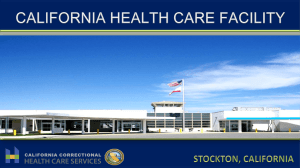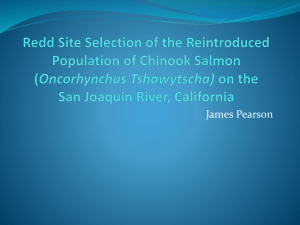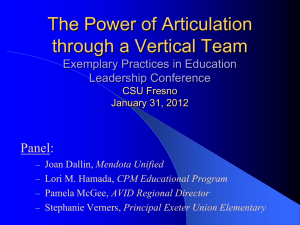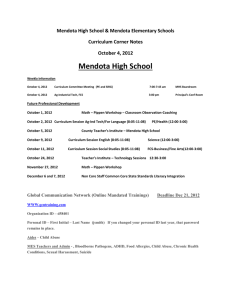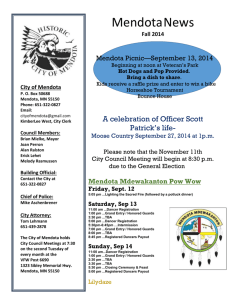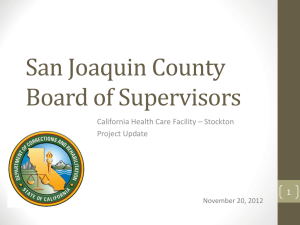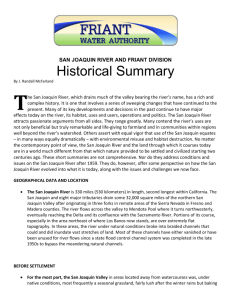Ane Diester 916-853-5348 Cell 530-863
advertisement
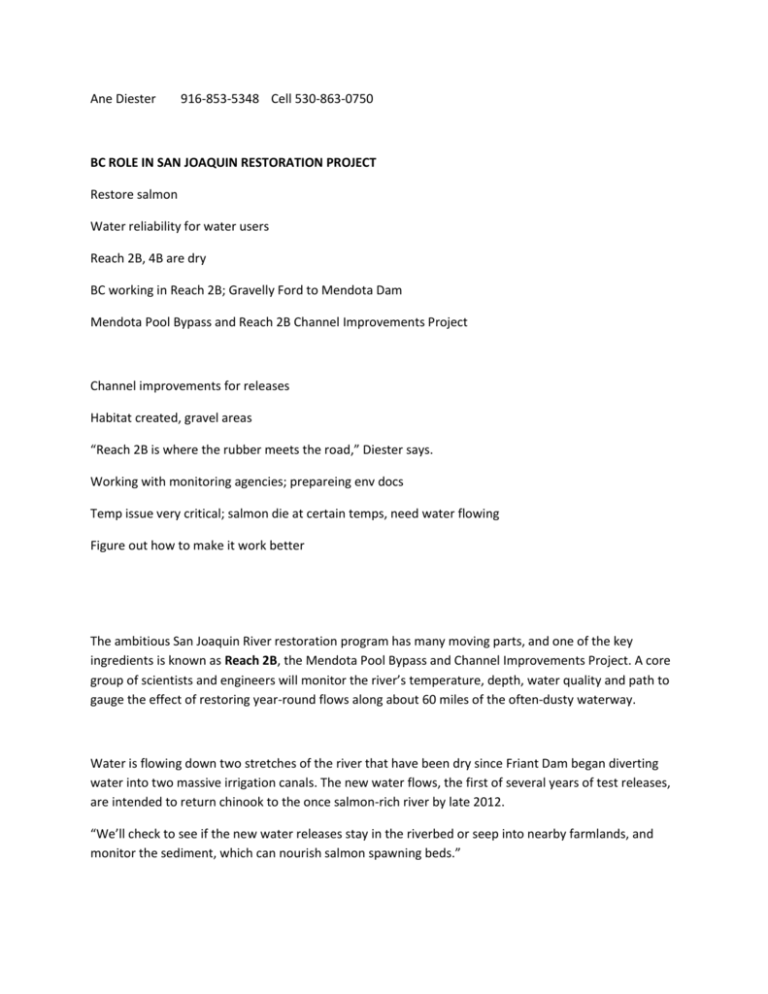
Ane Diester 916-853-5348 Cell 530-863-0750 BC ROLE IN SAN JOAQUIN RESTORATION PROJECT Restore salmon Water reliability for water users Reach 2B, 4B are dry BC working in Reach 2B; Gravelly Ford to Mendota Dam Mendota Pool Bypass and Reach 2B Channel Improvements Project Channel improvements for releases Habitat created, gravel areas “Reach 2B is where the rubber meets the road,” Diester says. Working with monitoring agencies; prepareing env docs Temp issue very critical; salmon die at certain temps, need water flowing Figure out how to make it work better The ambitious San Joaquin River restoration program has many moving parts, and one of the key ingredients is known as Reach 2B, the Mendota Pool Bypass and Channel Improvements Project. A core group of scientists and engineers will monitor the river’s temperature, depth, water quality and path to gauge the effect of restoring year-round flows along about 60 miles of the often-dusty waterway. Water is flowing down two stretches of the river that have been dry since Friant Dam began diverting water into two massive irrigation canals. The new water flows, the first of several years of test releases, are intended to return chinook to the once salmon-rich river by late 2012. “We’ll check to see if the new water releases stay in the riverbed or seep into nearby farmlands, and monitor the sediment, which can nourish salmon spawning beds.” ENDING? The nine-year project — the culmination of a legal settlement between farmers and environmentalists — will eventually reconnect the 350-mile river to the Pacific Ocean. Salmon could one day migrate from near Fresno to the ocean along portions of river that are now dry. Costs could run as high as $1.2 billion and big decisions remain on how exactly to restore parts of the river. Ane Deister As subconsultant to URS, BC is part of the consultant team selected by the United States Bureau of Reclamation (USBR) to conduct site-specific environmental assessments for Reach 2B of the San Joaquin River Restoration Project (SJRRP). The award is approximately $2.4 Million, with BC’s portion estimated at $770,000 for this Federal IDIQ contract. USBR indicated several optional tasks will be added as the project proceeds, which will increase the total contract value. Ane Deister (Sacramento) will serve as PM for BC and the single point-of-contact to coordinate deliverables and make sure they are consistent with the objectives of the SJRRP staff .The project team will provide technical assistance, facilitate internal coordination and synthesize information provided by the Work Groups into defensible products to support the SJRRP. This is a complex, fast-moving project requiring extensive coordination, clear communications and direction from USBR’s Project Management Team. The team will employ an adaptive management approach to provide assistance under the direction of Reclamation to the Implementing Agencies in response to the concerns of stakeholders and the public. The SJRRP is the result of a federally sanctioned settlement agreement between USBR, Friant Water Users and several environmental organizations led by NRDC. The program has two co-equal goals: restoration of a sustainable salmon population in the San Joaquin River, and water supply reliability for the Friant users. USBR is leading the program implementation, which involves NOAA Fisheries, US Fish and Wildlife Service, CA Department of Water Resources, CA Fish and Game, the Resources Agency and the Secretary of Interior. Reach 2B presently conveys a maximum flow of only 1,300 cubic feet per second (cfs) and the design restoration flow for the reach is 4,500 cfs. Restoration of this reach will include reconstructing the low flow channel and constructing a floodway to convey the design flow and enhance the geomorphic function and riparian habitat within the reach. This proposal was a collaborative effort between URS, BC and Entrix. Key participants in the proposal process from BC included: Ane Deister, Cindy Paulson (Walnut Creek), Dave Zuber (Sacramento), Lesly Nelson (Sacramento), and Margie Namba (Sacramento), with assistance from Sacramento marketing. Other key members of the BC project team will include: Ken Myers (Sacramento), Martin Steinpress (Walnut Creek), Brian Plude (Davis), Nathan Foged (Seattle), Robin Mooney (Walnut Creek), Paul Selsky (Sacramento), Ron Crites (Davis) and Jeff Bold (Davis). The San Joaquin River Restoration Program (SJRRP) is a comprehensive long-term effort to restore flows to the San Joaquin River from Friant Dam to the confluence of Merced River and restore a self-sustaining Chinook salmon fishery in the river while reducing or avoiding adverse water supply impacts from restoration flows. The SJRRP is a direct result of a Settlement reached in September 2006 on an 18-year lawsuit to provide sufficient fish habitat in the San Joaquin River below Friant Dam near Fresno, California, by the U.S. Departments of the Interior and Commerce, the Natural Resources Defense Council (NRDC), and the Friant Water Users Authority (FWUA). The Settlement received Federal court approval in October 2006. The Settlement is based on two goals: Restoration: To restore and maintain fish populations in "good condition" in the main stem of the San Joaquin River below Friant Dam to the confluence of the Merced River, including naturally reproducing and self-sustaining populations of salmon and other fish. Water Management: To reduce or avoid adverse water supply impacts to all of the Friant Division longterm contractors that may result from the Interim Flows and Restoration Flows provided for in the Settlement. The first water releases from Friant Dam, called Interim Flows, began at 6 p.m. on October 1. The U.S. Bureau of Reclamation and the California Department of Water Resources are preparing a joint Environmental Impact Statement/Environmental Impact Report for the project, pursuant to the National Environmental Policy Act (NEPA) and the California Environmental Quality Act (CEQA). The Mendota Pool Bypass and Reach 2B Channel Improvements Project includes the construction, operation, and maintenance of the Mendota Pool Bypass and improvements including the operation and maintenance of the San Joaquin River channel to allow Reach 2B to convey at least 4,500 cubic feet per second (cfs). Site-specific studies, including environmental analyses and engineering designs, will be initiated in summer 2009 for three of the Phase I actions identified in the Settlement. These studies will support the release of Interim Flows and other river modifications necessary to implement the Settlement. The studies will be conducted in compliance with the National Environmental Policy Act (NEPA) and California Environmental Quality Act (CEQA). The Bureau of Reclamation and the California Department of Water Resources (DWR) are proposing to prepare a joint Environmental Impact Statement/Environmental Impact Report (EIS/EIR), pursuant to the National Environmental Policy Act (NEPA) and the California Environmental Quality Act (CEQA), to evaluate effects of the proposed Mendota Pool Bypass and Reach 2B Channel Improvements Project (Proposed Action) under the San Joaquin River Restoration Program (SJRRP). The Proposed Action is a component of the San Joaquin River Settlement (October 2006) and is located in Madera and Fresno Counties. The proposed Mendota Pool Bypass would include a bypass around the Mendota Pool to convey at least 4,500 cfs around the Mendota Pool and re-connect with the San Joaquin River downstream of Mendota Dam. The Proposed Action could also include constructing a bifurcation structure at the upper end of the bypass to convey flows into the Mendota Pool Bypass. The proposed Mendota Bypass Bifurcation Structure would be designed to divert water from the San Joaquin River to the Mendota Pool, consistent with the design channel capacity of Reach 2B that conveys flows to the Mendota Pool. The bifurcation structure would be designed to direct fish into the bypass channel and minimize or avoid fish passage into the Mendota Pool. Specific bypass alignments and facilities locations will be determined through the course of this site-specific study. Reach 2B of the San Joaquin River extends from the Chowchilla Bypass Bifurcation Structure to the Mendota Dam. Proposed improvements to Reach 2B would include modifications to the San Joaquin River channel from the Chowchilla Bypass Bifurcation Structure to the new Mendota Bypass Bifurcation Structure to provide a capacity of at least 4,500 cfs incorporating new floodplain and riparian habitat. Specific channel modification actions would be determined through the course of this site-specific study. These actions could consider, but may not be limited to, fisheries requirements, land uses, subsurface conditions, topography, and the condition of existing levees.
